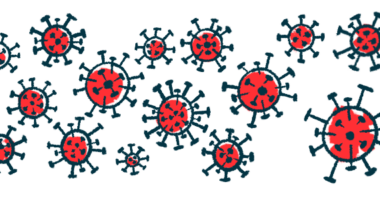New viral carrier shows promise for brain-targeted gene therapies
Engineered AAV crosses blood-brain barrier in animal model

Scientists at the Broad Institute of MIT and Harvard have engineered a harmless adeno-associated virus (AAV) that can efficiently reach the brain, potentially improving the efficacy of brain-targeted gene therapies for neurological conditions such as Huntington’s disease.
Current AAVs that deliver gene therapies to cells in the body via injection into the bloodstream cannot efficiently cross the blood-brain barrier (BBB), the highly selective membrane that regulates what substances from the bloodstream can access the central nervous system (CNS), which consists of the brain and spinal cord.
In a mouse model modified to produce the human version of an important BBB protein, the newly engineered AAV was more widely distributed across the brain and more effective at delivering a gene therapy to brain cells than AAV serotype 9, which is used in an approved CNS-targeted gene therapy.
The study, “An AAV capsid reprogrammed to bind human transferrin receptor mediates brain-wide gene delivery,” was published in Science.
“Since we came to the Broad we’ve been focused on the mission of enabling gene therapies for the central nervous system,” Ben Deverman, PhD, the study’s senior author and director of vector engineering at the Broad’s Stanley Center for Psychiatric Research, said in an institute press release. “If this AAV does what we think it will in humans based on our mouse studies, it will be so much more effective than current options.”
Potential to change lives
Ken Chan, PhD, one of the study’s first co-authors and group leader in Deverman’s group, said the AAVs “have the potential to change a lot of patients’ lives.”
In Huntington’s, defects in the HTT gene lead to toxic clumps of the huntingtin protein, which are thought to damage various parts of the brain, triggering the onset of symptoms.
Gene therapy, which works by delivering to cells genetic material meant to counterbalance a genetic defect, can potentially treat disorders caused by mutations in a single gene, such as Huntington’s.
Most of these therapies use modified, harmless AAVs to deliver the therapeutic cargo to cells. However, current AAVs cannot efficiently cross the BBB, which protects the brain from harmful substances in the blood while allowing essential nutrients and certain molecules to pass through.
To address these limitations, the researchers engineered an AAV that binds to the transferrin receptor (TfR1), a cell surface protein that is highly present in the human BBB and is an established target of antibody-based therapies designed to reach the brain.
To find such a virus, they first screened large AAV libraries in test tubes. Top candidates were then tested in cells and mice (in vivo) modified to produce human TfR1. Screening against a human protein in mice was done to improve the chances that gene therapies using these AAVs would work in human patients.
“We’ve learned a lot from in vivo screens but it has been tough finding AAVs that worked this well across species,” said research scientist Qin Huang, PhD, the other co-first author of the study. “Finding one that works using a human receptor is a big step forward.”
Injecting the top AAV candidate, called BI-hTFR1, into the bloodstream of TfR1-modified adult mice dramatically increased levels of the AAV in the CNS compared with unmodified mice. This demonstrated that the AAV was indeed crossing the BBB by binding to human TfR1.
In different brain regions, BI-hTFR1 reached up to 71% of nerve cells and 92% of astrocytes, specialized cells in the brain that provide support to nerve cells.
The team then compared BI-hTFR1 with AAV9, an AAV used as a delivery vehicle for Zolgensma (onasemnogene abeparvovec-xioi), a gene therapy approved for the neuromuscular disorder spinal muscular atrophy.
They found that BI-hTFR1 levels in brain tissue were up to 50 times higher than those of AAV9.
Targeting ‘whole-brain’ diseases
As a model for gene therapy, researchers used the new AAV to deliver a healthy copy of the human GBA1 gene, which encodes an enzyme called beta-glucocerebrosidase, to the modified mice. Mutations in this gene cause Gaucher disease and are linked to Parkinson’s disease. Both of those are neurological conditions.
Compared with AAV9, BI-hTFR1 delivered 30 times more copies of the GBA1 gene to brain cells and substantially increased the beta-glucocerebrosidase activity in the brain and cerebrospinal fluid, which surrounds the brain and spinal cord.
“When we think about gene therapy for a whole-brain disease … you need really systemic delivery and broad biodistribution in order to achieve anything,” said Eric Minikel, PhD., senior group leader at the Broad. “Naturally occurring AAVs just aren’t going to get you anywhere,” Minikel said. “This engineered [AAV] opens up a world of possibilities.”
In addition to targeting a human protein, the fact that BI-hTFR1 has a similar production yield to AAV9 using scalable manufacturing methods makes it ideal for CNS-targeting gene therapy, the researchers noted.
Researchers at Apertura Gene Therapy, a biotech company co-founded by Deverman, are already developing new CNS-targeting gene therapies using the new AAV.
The scientists believe that further research can help improve the AAVs’ gene-delivery efficiency to the CNS, the institute said. It may also help reduce AAV accumulation in the liver, and prevent their inactivation by antibodies in some patients — two known complications of current viral-based gene therapies.








